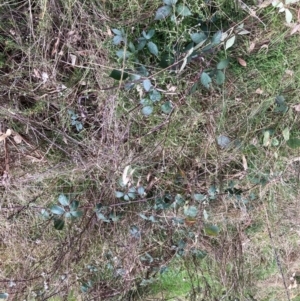Blackberry at Hackett, ACT
Identification history
| Rubus anglocandicans | 13 Sep 2022 | Tapirlord | ||
| Rubus fruticosus | 13 Sep 2022 | waltraud |
Identify this sighting
Please Login or Register to identify this sighting.
User's notes
Some vines over 2m long and layering at tip (roots already developed)
I treated the main stems and the tips that were layered by cut and spray.
5 comments
Tapirlord
wrote:
13 Sep 2022
So this ID is very likely incorrect, but talking about the taxonomy of this genus is a one big messy lump of conflicting sources. As with the prickly pears (Opuntia), the keys we use in Australia are long outdated or incomplete, which means whatever is on the census is also very likely incorrect, I believe we use Rubus anglocandicans as teh catch all name on CNM. This will need revision at some stage.
Mike
wrote:
13 Sep 2022
I would prefer to use Rubus fruticosus species aggregate which is listed as a Weed of National Significance. The aggregate includes several European species and Rubus anglocandicans is the commonest local one. Control is somewhat dependent on the species but identification should be left to the experts in the field. If you are sure it is R. anglocandicans then use the species name.
waltraud
wrote:
29 Sep 2022
I would not be able to distinguish the 2 species R fruticosus and R anglocandicans. What are the features?
There are more Rubus 'whatsoever" growing nearby which I think from appearance and growth habit the same as those featured above: high arching vines, root formation at the tips of vines, without leaves, reshooting, buds ie deciduous or semi-deciduous. I have yet to take photos and load up CNM.
From the little I know however the above description fit various species/hybrids.
I'm unaware of WoNS status - I thought WoNS covers all 14 or so Rubus fruticosus aggregate species (and hybrids) of which R anglocandicans is a member?
What are the features to look for / take photos of? which parts of plants should I collect for a botanist to identify?
There are more Rubus 'whatsoever" growing nearby which I think from appearance and growth habit the same as those featured above: high arching vines, root formation at the tips of vines, without leaves, reshooting, buds ie deciduous or semi-deciduous. I have yet to take photos and load up CNM.
From the little I know however the above description fit various species/hybrids.
I'm unaware of WoNS status - I thought WoNS covers all 14 or so Rubus fruticosus aggregate species (and hybrids) of which R anglocandicans is a member?
What are the features to look for / take photos of? which parts of plants should I collect for a botanist to identify?
Tapirlord
wrote:
29 Sep 2022
I wondered this myself a little while ago, and have consulted a number of expert contacts in this regard. Australian plant folk are divided on whether to aim for a species level ID, or just lump all sightings within the R.fruticosus aggregate. Supposedly R.anglocandicans can be distingiushed by high arching glabrous stems that lack a whitish scaly covering, so I suspect if you were to take a sample to Isobel thats what she would say.
However, as with the Opuntia species we are very much behind on the current taxonomy of brambles in Australia, so much so that R.anglocandicans is no longer a current name rather it is now Rubus grabowskii. I'm not quite clear on what we are doing with blackberries on CNM, but will bring this up with Michael at some stage. Though perosnally I think we should lump them all in the species aggregate and be done with it, they are all about the same.
I wouldn't waste your energy seeking a outdated ID with this complex, all members of the aggregate have WoNS listings.
However, as with the Opuntia species we are very much behind on the current taxonomy of brambles in Australia, so much so that R.anglocandicans is no longer a current name rather it is now Rubus grabowskii. I'm not quite clear on what we are doing with blackberries on CNM, but will bring this up with Michael at some stage. Though perosnally I think we should lump them all in the species aggregate and be done with it, they are all about the same.
I wouldn't waste your energy seeking a outdated ID with this complex, all members of the aggregate have WoNS listings.
waltraud
wrote:
30 Sep 2022
this is very useful practical advice -thanks a million
We will probably change the R. anglocandicans back to the aggregate on our Flora list which we had before.
We will probably change the R. anglocandicans back to the aggregate on our Flora list which we had before.
Please Login or Register to comment.
Nearby sightings
Location information
- Coordinates 149.167039-35.254628
- Altitude 640.4m
- Maps Mount Majura
- Places Hackett, ACT
Sighting information
- 16 - 100 Abundance
- 13 Sep 2022 11:34 AM Recorded on
- waltraud Recorded by
Species information
- Rubus anglocandicans Scientific name
- Blackberry Common name
- Not Sensitive
- Exotic
- Noxious or High Risk Weed or Pest
- Up to 1491.44m Recorded at altitude
- Machine learning
-
In flower
-
Synonyms
Rubus fruticosus species aggregate Rubus fruticosus spp. agg.
Record quality
- Images or audio
- More than one media file
- Confirmed by an expert moderator
- Nearby sighting(s) of same species
- GPS evidence of location
- Description
- Additional attributes























